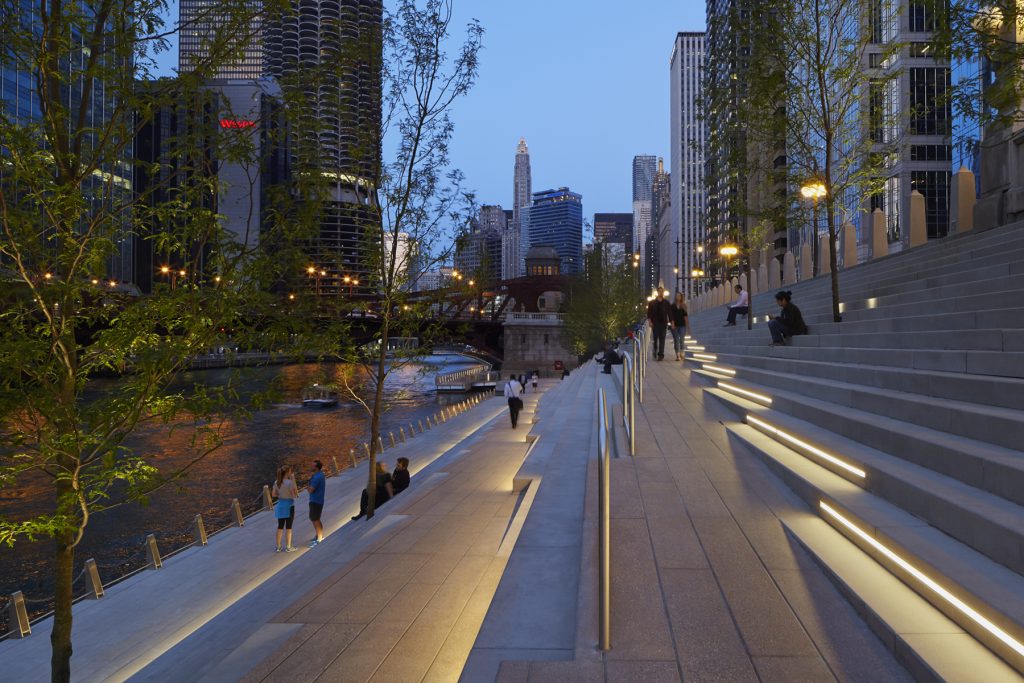
Are livable cities the key to a sustainable future for those of us living on this planet? Many urban planners and architects think so.
Because by 2050, there will be 6.3 billion city dwellers worldwide, a 63% increase from today.
According to architect Carol Ross Barney, who I heard speak at NeoCon last week, the elements that stitch a city together — schools, cultural institutions, public transportation, and public spaces are what bring value to dense urban living.
She left out hospitals and clinics in that mix. Wonder why?
Perhaps it’s because hospitals, clinics, and senior living communities haven’t always been well integrated into the community — or offered reasons to visit their properties other than for healthcare services.
But that is changing. Here are some examples:
- Bridgepoint Health in Toronto put its new hospital next to a nearby park so that people could walk from the park to its outdoor labyrinth, gardens, and terrace spaces.
- The new CHUM hospital in Montreal made its building street- and transit-friendly, and plans to build a public amphitheater in its second phase.
- Rose Villa senior living community in Portland has a town center with retail shops, restaurants, a gym, and an outdoor plaza for hosting farmer’s markets, street fairs, and other events.
- Green River is a four-star restaurant on the 18th floor of Chicago Northwestern Memorial Hospital’s outpatient care pavilion.
Lessons Learned from Chicago’s Riverwalk
But let’s get back to Ross Barney. Her talk at NeoCon mostly focused on her firm’s work to turn a previously unused space along the Chicago River in downtown Chicago into a walk-able, activity-centered, destination spot.
The wildly successful Riverwalk is a continuous path with different experiences — including places to dock boats or hop into a kayak, a City Winery with outdoor seating, a Vietnam memorial, outdoor theater, floating gardens, fishing jetties, and much more.
Last spring and summer, so many people visited the City Winery on the Riverwalk that it ran out of its supply of wine for the year in August. And that’s $15 per glass of wine, folks.
What’s the lesson for urban healthcare facilities here? It’s simple, really. If you build it, they will come.
Of course, that’s assuming that you make it walk-able and transit-friendly and build it in a way that engages people.
When you think about it, a livable city is a healthy city. And promoting healthy lifestyles is the future of healthcare.
P.S. Please do me a favor — if you liked this post and like this blog, please share it with others by sending them the link or posting it on your Twitter, LinkedIn, or Facebook. Also, don’t forget to subscribe, so you’ll get emails when new content is posted. Thanks!
If you like this post, please share.

What’s my story? I’m a healthcare and senior living design knowledge expert who writes and speaks frequently about trends and issues affecting these two industries. I’m also a strategic marketing consultant and content creator, working with companies and organizations who want to improve the quality of healthcare and senior living through the design of the physical environment. You can reach me at sara@saramarberry.com.


2 Responses
So true here Sara! City planners need to take notice here as well as healthcare executives as they look at their surroundings. One has to plan with other entities for this concept to be a reality.
Pleasant pictures to think about. But cities include those who do not want “senior” isolation, and includes areas where people are not walking because they are rightly afraid to leave their own building or even their own apartment. Healthy cities must spend some of the money on them – even if it means less for concerts and kayaks. Even if it means spending more on law enforcement in crowded areas.